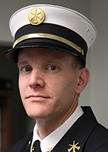Editor’s Opinion Chris Mc Loone
I’m Generation X, but my kids have been known to call me a boomer when it comes to smartphones or this new language they speak. I am 99% sure that when they say, “Dad, that was thurl,” they mean whatever it is I just did is good.

I was part of a discussion a year ago about why it seems firefighters are slow to accept new technologies. My contention then, and today, is that when the benefits of the technology are obvious, the fire service will jump onboard immediately. I cited the example of thermal imaging cameras (TICs). The importance of this technology and how it would enable us to do our jobs more efficiently and assist with victim removal was obvious. The barrier back then was the price associated with implementing the technology. As soon as that price point dropped, fire departments around the world jumped onboard.
I recently read a post on the “GLORY DAYS; With NYC firefighters 1980-9/11” Facebook page that recounted when the FDNY began using two-way radios, or “handi-talkies.” I thought it was another good example of how a new technology’s benefits were obvious. Clearly it was better to be able to talk to someone right away rather than send aides in and out of a building with orders or try to communicate with hand signals.
Today, we are discussing ways to get TICs into the hands of every firefighter on a crew—and some departments have already started doing it. And, depending on the size of a department, crews exiting pumpers and ladder trucks today are all equipped with two-way radios for every member.
Fire department drones are another clear example of a newer technology immediately being used. So, what gives? Are these other technologies just too niched? What are we not doing to communicate the usefulness of these technologies?
Is it a personnel thing? I remember back when I was a lieutenant. I was young and wanted to be inside on everything. We were spec’ing new SCBA, and we were also looking into some of the tools available to integrate with the SCBA to assist with crew accountability. It would require a dedicated person to be monitoring the software package for the IC. I remember saying to my chief that I definitely didn’t want to be that guy. I’m pretty sure I was the most vocal person on that, but I’m also pretty sure that the rest of the line felt the same. We all want to be where the action was vs. watching a computer screen. We ended up not opting for the other tools. We didn’t have the interest in learning the tools and, in actuality, it was very early in the game for them.
Now, we are at a point where some of these tools have become very powerful and, more importantly, reliable. I’m at a point in my career where being “the guy” standing at the computer screen doesn’t seem as bad as it did before.
As senior members, we love talking about how things used to be done. When I talk with our younger members about our old ways, I don’t do it in such a way to say the way we did it was better. Sometimes it’s, “I can’t believe we did it like that.” Much like laying dual 2½- or 3-inch lines is a foreign concept to me, some of our newer members cannot believe that there was a time that there was only one two-way on the truck for the officer. If one of our pumpers was working, the radio was at the pump panel, and you couldn’t walk around with it. I still remember the “bag phone” we had on our first-out engine. Map books have given way to iPads and MDCs. With all this being the case, we senior members have to do a better job of explaining why the technologies available to us today are worth looking into. The “why” is what’s important. And, it’s up to us senior members to explain it. We have to make it clear how technology during our career has advanced fire service operations. Younger members don’t know of a time without TICs, two-ways for all, integrated PASS, MDCs, etc. We need to explain how we did it, why it’s great that it changed, and why we need to consider how to do things differently in the future. It’s the “why,” and we have to do a better job of explaining it.

